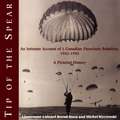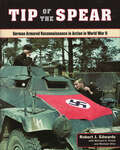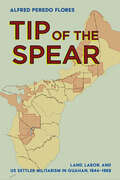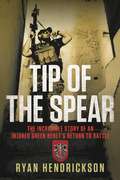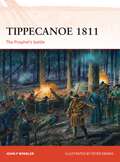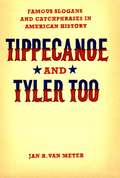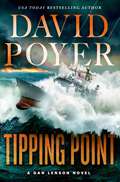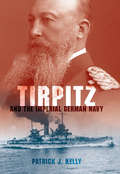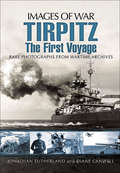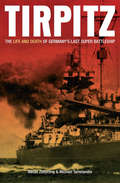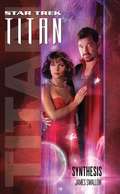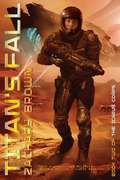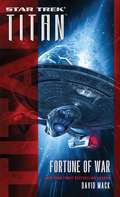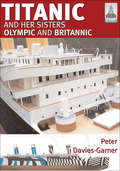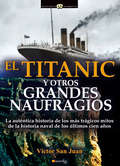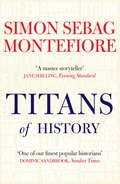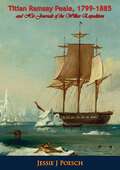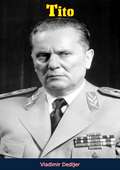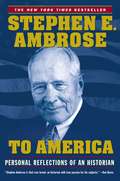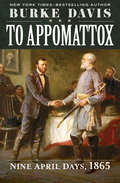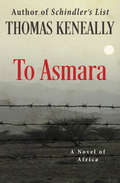- Table View
- List View
Tip of the Spear: An Intimate Account of 1 Canadian Parachute Battalion, 1942-1945
by Colonel Bernd Horn Michel WyczynskiIn the midst of the Second World War, the Germans introduced a new kind of warfare that had never been seen before, featuring a new kind of soldier: the paratrooper. The public and military alike were astonished by the feats of daring and martial prowess displayed by the intrepid troops, who soon became the epitome of the modern combat soldier. The Allies countered by setting up their own airborne forces. In Canada, 1 Canadian Parachute Battalion was established to serve as the "tip of the spear" of Allied attacks. In fact, it was this battalion that was first into Normandy for the D-Day invasion. Tip of the Spear tells in stunning black-and-white pictures the story of the Battalion from its inception in 1942 to its disbandment in 1945. Without question, the Battalion - or more accurately, its members - laid the foundation and established the airborne legacy that other Canadian airborne establishments could proudly follow and build on.
Tip of the Spear: German Armored Reconnaissance in Action in World War II
by Robert J Edwards Michael H Pruett Michael OliveA comprehensive pictorial study of Germany&’s armored reconnaissance operations across all WWII combat zones. From the invasions of Poland and France to the advances on the Eastern Front and in North Africa, German tank and infantry units unleashed brutal displays of power. But it was the German armored reconnaissance that laid the groundwork for these stunning victories. In Tip of the Spear, delves into German reconnaissance operations through firsthand accounts, after-action reports, and an extensive collection of wartime photographs. The author of Scouts Out, the first extensive treatment of the subject in English, Edwards delves deeper into the subject of German reconnaissance with extensive analysis of everything from tactics and doctrine to vehicles and commanders.
Tip of the Spear: Land, Labor, and US Settler Militarism in Guåhan, 1944–1962 (The United States in the World)
by Alfred Peredo FloresIn Tip of the Spear, Alfred Peredo Flores argues that the US occupation of the island of Guåhan (Guam), one of the most heavily militarized islands in the western Pacific Ocean, was enabled by a process of settler militarism. During World War II and the Cold War, Guåhan was a launching site for both covert and open US military operations in the region, a strategically significant role that turned Guåhan into a crucible of US overseas empire. In 1962, the US Navy lost the authority to regulate all travel to and from the island, and a tourist economy eventually emerged that changed the relationship between the Indigenous CHamoru population and the US military, further complicating the process of settler colonialism on the island.The US military occupation of Guåhan was based on a co-constitutive process that included CHamoru land dispossession, discursive justifications for the remaking of the island, the racialization of civilian military labor, and the military's policing of interracial intimacies. Within a narrative that emphasizes CHamoru resilience, resistance, and survival, Flores uses a working class labor analysis to examine how the militarization of Guåhan was enacted by a minority settler population to contribute to the US government's hegemonic presence in Oceania.
Tip of the Spear: The Incredible Story of an Injured Green Beret's Return to Battle
by Ryan HendricksonThe inspiring true story of a US Special Forces soldier who was medically retired after stepping on an IED, and his incredible return to active duty.Sergeant First Class (SFC) Ryan Hendrickson is a brave, determined, and courageous soldier -- a Green Beret clearing the way for his twelve-man team while conducting combat operations against the Taliban. As the "tip of the spear," his role is to ensure the route taken by U.S. and Afghan troops are free of IEDs -- improvised explosive devices. Many soldiers do not survive their last step; those who do often lose at least one limb.While rescuing an Afghan soldier outside a mud-hut compound in 2010 -- knowing that he was in "uncleared" territory -- Ryan stepped on an IED with his right foot. The device exploded, leaving his foot dangling at the end of his leg.American soldiers losing a limb is an all-too-common occurrence. But what makes Ryan's story different is that after undergoing two dozen surgeries and a tortuous rehabilitation, he was medically retired but fought to return to active duty. Multiple skin grafts to his leg and right foot successfully reattached his lower leg, and he was aided in his recovery by wearing a new prosthetic device known as an IDEO (Intrepid Dynamic Exoskeletal Orthosis). Once he passed a series of crucial physical tests, Ryan was able to rejoin the Green Berets within a year and physically perform his duties, redeploying to Afghanistan in March 2012.In 2016, he volunteered to return to Afghanistan with Bravo Company, 2nd Battalion, 7th Special Forces Group. During a firefight with the Taliban, he risked his life under heavy enemy fire to rescue three Afghan soldiers cut off from friendly forces and return the bodies of two dead Afghan soldiers under the ethos that "no one gets left behind." For his heroic efforts on the battlefield, SFC Ryan Hendrickson was awarded a Silver Star, the nation's third-highest award for valor.An engaging and harrowing account, Tip of the Spear tells the amazing story of one Green Beret's indomitable spirit.
Tippecanoe 1811
by Peter Dennis John F. WinklerThis is the gripping story of the Tippecanoe campaign of 1811: "The prophet's battle". It was a conflict born out of festering tensions inscribed by the 1795 Treaty of Greeneville, which had concluded the Northwestern Indian War and attempted to prevent white settlers' encroachment onto newly-defined Indian territories. For 16 years there had been peace, but in 1811 the number of settlers in the Ohio territory had swollen from 3,000 to 250,000. War was again coming to the North West. Within these pages John F. Winkler explores the dramatic buildup to the war and provides a clear view of the intense fighting with the aid of superb illustrations and maps. He explores the mystical figure of Tenskatawa, who came to be known as "The prophet" and who tried to unite the tribes of the Northwest to drive the American settlers back once and for all - promising a great success that he had seen in a vision. However it was his brother, the charismatic war leader Tecumseh who would organize the tribes militarily, and the Battle of Tippecanoe would be joined as a stealthy assassination attempt by 100 hand-picked warriors trying to kill William Henry Harrison. Kill Harrison, The Prophet asserted, and the rest would fold. Uncover the truth about the brutal combat that followed, and the impact of the battle on the War of 1812.
Tippecanoe and Tyler Too: Famous Slogans and Catchphrases in American History
by Jan R. Van MeterIn individual entries on slogans and catchphrases from the early seventeenth to the late twentieth century, Jan Van Meter reveals that each one is a living, malleable entity that has profoundly shaped and continues to influence our public culture. From John Winthrop's "We shall be as a city upon a hill" to Martin Luther King Jr.'s "I have a dream" and Ronald Reagan's "Mr. Gorbachev, tear down this wall", each of Van Meter's selections emerges as a memory device for a larger political or cultural story. Taken together in Van Meter's able hands, these famous slogans and catchphrases give voice to our common history even as we argue about where it should lead us.
Tipping Point (A Dan Lenson Novel #15)
by David PoyerCaptain Dan Lenson is under fire both at sea, and in Washington. His command of the first antiballistic-missile-capable cruiser in the Fleet, USS Savo Island, is threatened when he's called home to testify before Congress. There, he must defend his controversial decision to prevent a massive retaliatory missile attack by Israel against civilian targets in the Mideast. Shaken by the near-end of his career, Lenson returns to command uncertain of his own future, but determined to do his best by a damaged ship and an increasingly divided crew. Ordered to the Indian Ocean, Savo cruises off East Africa, protecting shipping lanes from pirates. But this seemingly-routine patrol turns ominous when an unknown assailant begins assaulting female crew members. But then, an explosive showdown begins between India and Pakistan. . . with Savo Island, and her unique but not yet fully battle-ready ability to intercept ballistic missiles, standing alone between two nations on the brink of the first theater nuclear war. Dan will have to battle tsunami-driven seas, incoming weapons, and a quickly tilting balance of power, as China moves inexorably in her bid to displace America in the far Pacific. The fifteenth novel in David Poyer's acclaimed series of naval adventures featuring Dan Lenson,Tipping Point is an action-packed, utterly authentic story of duty, war, and the stress of command, by the most popular living author of American sea fiction.
Tirpitz: And the Imperial German Navy
by Patrick J. Kelly&“A first-rate biography of this grand admiral who is better known for his political skills than his naval ones.&” —US Naval Insitute Proceedings Grand Admiral Alfred von Tirpitz (1849–1930) was the principal force behind the rise of the German Imperial Navy prior to World War I, challenging Great Britain&’s command of the seas. As State Secretary of the Imperial Naval Office from 1897 to 1916, Tirpitz wielded great power and influence over the national agenda during that crucial period. By the time he had risen to high office, Tirpitz was well equipped to use his position as a platform from which to dominate German defense policy. Though he was cool to the potential of the U-boat, he enthusiastically supported a torpedo boat branch of the navy and began an ambitious building program for battleships and battle cruisers. Based on exhaustive archival research, including new material from family papers, Tirpitz and the Imperial German Navy is the first extended study in English of this germinal figure in the growth of the modern navy. &“Well written and based on new sources . . . allows the reader deep insights into the life of a man who played a very important role at the turn of the last century and who, like almost nobody else, shaped German policy.&” —International Journal of Maritime History &“An invaluable reference work on Tirpitz, the Imperial German Navy, and on politics in Wilhelmine Germany.&” —The Northern Mariner
Tirpitz: The First Voyage (Images Of War Ser.)
by Diane Canwell Jonathan SutherlandThe photos in this book are taken from an unpublished album belonged to a member of the crew of famous German Battleship Tirpitz. It is a little known fact that before the start of World War Two the ship went on a shakedown voyage into the Atlantic, traveling north into Arctic waters and south into the more tropical climbs of the Caribbean. There are superb photos of the officers and crew both above and below decks, including some unique shots of the crew during their stint on a magnificent sail training vessel. Other stunning shots show the vessels mighty weapons during gunnery practice during her sea trials. This unique collection gives a close up view of one of the most powerful ships of World War Two, a ship that proved to be a persistent thorn in the side of the Royal Navy until sunk in Norway towards the end of the war.\
Tirpitz: The Life and Death of Germany's Last Super Battleship
by Niklas Zetterling Michael TamelanderThe authors of Bismarck deliver &“a very good account of the Tirpitz and of the naval war in the North Atlantic and Norwegian waters&” during World War II (NYMAS Review). After the Royal Navy&’s bloody high seas campaign to kill the mighty Bismarck, the Allies were left with an uncomfortable truth—the German behemoth had a twin sister. Slightly larger than her sibling, the Tirpitz was equally capable of destroying any other battleship afloat, as well as wreaking havoc on Allied troop and supply convoys. For the next three and a half years, the Allies launched a variety of attacks to remove Germany&’s last serious surface threat, hidden within fjords along the Norwegian coast. Trying an indirect approach, the British launched one of the war&’s most daring commando raids—at St. Nazaire—in order to knock out the last drydock in Europe capable of servicing the Tirpitz. Of over six hundred commandos and sailors in the raid, more than half were lost during an all-night battle that succeeded, at least, in knocking out the drydock. It was not until November 1944 that the Tirpitz finally succumbed to British aircraft armed with ten-thousand–pound Tallboy bombs, the ship capsizing at last with the loss of one thousand sailors. In this book, military historians Niklas Zetterling and Michael Tamelander, authors of Bismarck: The Final Days of Germany&’s Greatest Battleship, illuminate the strategic implications and dramatic battles surrounding the Tirpitz, a ship that may have had greater influence on the course of World War II than her more famous sister. &“A riveting story . . . keeps the reader engaged.&” —Nautilus, A Maritime Journal of Literature, History and Culture
Titan #6: Synthesis (Star Trek: The Next Generation #No. 6)
by James SwallowThe Starship Titan continues on her outward voyage of discovery. Ranging farther and farther from Federation space, Captain William Riker and the crew look forward to living Starfleet's mission: seeking out new life, discovering new civilizations.Striking a "sandbank" -- a spatial distortion -- the Titan is knocked out of warp, her crew shaken up but uninjured. Titan has stumbled across a battlefield, and floating in it, shattered and in pieces, are the remains of a ship. Searching for survivors, they discover the ship never had a crew. The away team removes the computer core, looking for answers. Once the device is restored, it becomes clear this is not just a computer, but a thinking, reasoning artificial intelligence. It identifies itself as SecondGen White-Blue, and it comes from a civilization composed entirely of sentient computers. Eons ago these artificial intelligences were charged to be the first line of defense against The Null -- a destructive force so all-consuming that generation upon generation have waged unending war trying to find a way to beat back this terror. Captain Riker offers to assist them, but years of war have left the AIs distrustful and suspicious, especially of organics. The tide of the battle is turning, and The Null is winning. Set free, it will destroy everything in this system and then, unchecked, spread its mindless destruction into the heart of the Federation.
Titan's Fall: The Darkside War; Titan's Fall; Jupiter Rising (The Icarus Corps #2)
by Zachary BrownIn book two of the fast-paced Icarus Corps series, the Colonial Protection Forces wages war on the Conglomeration making a stand on Titan—and this battle may be the final one.The rapacious alien forces have taken their war to our solar system. Now that the human and PAC forces won a decisive battle on the moon, they need to try to head off the coming armada before their overpowering strength is amassed and The Icarus Corps is once again on the front line. But are they there just for fodder? And what exactly are they fighting for: Continued subjugation within the PAC or Earth first? Book two in The Icarus Corps, Titan’s Fall continues the team’s adventures as they wards off a fierce race of alien conquerors as they fight for humanity’s place at the vanguard of of this galactic war.
Titan: Fortune of War (Star Trek)
by David MackAn original spin-off novel set in the popular Star Trek: The Next Generation universe from New York Times bestselling author David Mack.Death slumbers in the ashes of silent planets, waiting to be awakened and unleashed… Twenty years have passed since the interstellar scourge known as the Husnock were exterminated without warning by a being with godlike abilities. Left behind, intact but abandoned, their desolate worlds and derelict ships brim with destructive potential. Now a discovery by a Federation cultural research team has drawn the attention of several ruthless factions. From black market smugglers to alien military forces, it seems every belligerent power in the quadrant hopes to capture the Husnock's lethal technology. All that stands between the galaxy and those who have come to plunder the cruelest secrets of the Husnock are Admiral William Riker, Captain Christine Vale, and the crew of the Starship Titan. ™, ®, & © 2017 CBS Studios, Inc. STAR TREK and related marks and logos are trademarks of CBS Studios, Inc. All Rights Reserved.
Titanic and Her Sisters Olympic and Britannic: And Her Sisters Olympic And Britannic (ShipCraft #18)
by Peter Davies-GarnerThe ShipCraft series explores the iconic pleasure vessels Titanic, Olympic, and Britannic in fully illustrated detail for building your own model ship. In the first of the ShipCraft series to cover non-naval vessels, this meticulously researched and illustrated volume looks at the legendary cruise ship RMS Titanic and her sisters, Olympic and Britannic. Written for the serious model ship builder, this book not only covers the many model kits available, but a concise history of the ship&’s class, including every detail that contributed to the ship&’s creation. Accompanied by hundreds of photographs of models in various scales, the text covers paint colors, line drawings, and scale plans, as well as the differences in the ships&’ appearance over time. An invaluable resource on available models, their pros and cons, and ways to modify and customize each one, this ShipCraft title concludes with a reference section essential to any modeler.
Titanic y otros desastres navales (Historia Incógnita)
by Víctor San JuanLa auténtica historia de los más trágicos mitos de la historia naval de los últimos cien años. Titanic, Príncipe de Asturias, Lusitania, Andrea Doria,… Colosales catástrofes, secretos ocultados por los gobiernos, los más estremecedores desastres navales de los últimos cien años. Asómbrese con las grandes tragedias del mar del último siglo, siniestros, accidentes o pérdidas de grandes buques mercantes, militares y de pasajeros que provocaron enormes pérdidas humanas y desastres ecológicos como resultado de imprudencias humanas o fallos técnicos. La docena de casos más célebres de accidentes navales del siglo XX, descritos y analizados en esta obra divulgativa de rigurosa investigación. Las causas, cómo se produjeron los siniestros y sus consecuencias. Pocos sucesos atrajeron la atención, impresionaron o estremecieron el ánimo de varias generaciones tanto como el siniestro del Titanic, donde perdieron la vida más de mil quinientas personas, el desafortunado fin del Lusitania, el Andrea Doria o el escalofriante naufragio del Príncipe de Asturias.
Titans of History
by Simon Sebag MontefioreIn The Titans of History, Simon Sebag Montefiore brings together a vivid and compelling selection of the lives of the towering figures that, for better of for worse, have changed the course of history. The 14th-century Mongol warlord Tamerlane, who once ordered the building of a pyramid of 70,000 human skulls from those that his army had beheaded, rubs shoulders with Oskar Schindler, the man whose selfless heroism saved over 1,000 Jews from death at the hands of the Nazis. In between these two extremes are those extraordinary figures, like Henry VIII, in whom good and evil were mixed promiscuously.Inspiring and horrifying in equal measure, in The Titans of History, Simon Sebag Montefiore has created an engaging, innovative and authoritative window into the history of the world.
Titian Ramsay Peale, 1799-1885, and His Journals of the Wilkes Expedition
by Jessie J PoeschTitian was a son of renowned portrait artist and museum founder Charles Wilson Peale from Philadelphia. Titian was an artist, naturalist and explorer, who accompanied the Wilkes Exploratory Expedition of the American Northwest in 1838-1842. He collected and studied shells, birds, plants and animals.
Tito (World Affairs Ser.)
by Vladimir DedijerTHE STORY, TOLD LARGELY BY HIMSELF, OF MARSHAL TITO OF YUGOSLAVIA—THE MAN WHOM STALIN MOST HATES AND FEARSTHE FIRST BIG HOLE in the iron curtain was cut in 1948 by Marshal Tito and the Yugoslavian people when they walked out of the Cominform, defying Stalin, the Red Army, and Moscow’s secret police. This was the first rebellion of a Soviet satellite state. It is not likely to be the last.Here is the only authentic inside story of this decisive moment in modern history, told in the context of Tito’s life, with about forty per cent of the text in Tito’s own words, recorded by one of his closest friends. Here is the story of Tito’s personal relations with Stalin, how the leaders of the Communist world would drink and talk and joke with each other, how Stalin felt about the Communists in Greece and China, the true stories of Dimitrov, Gomulka, Anna Pauker and the fierce struggle for power which goes on among the rulers of the Communist world. No other man has seen this world on the top level and survived to tell it.It is told here in the exciting story of the life of an itinerant machinist who wandered around Europe, Russia and the revolutionary movement until Hitler’s attack on his country in 1941 threw him into leadership of the Yugoslav Partisan Army.
Tito, Mihailovic, and the Allies
by Walter R. RobertsThis new edition contains a new foreword by the author.
To All The Living: Imperial War Museum Wartime Classics
by Monica FeltonIn January 1941 Griselda Green arrives at Blimpton, a place 'so far from anywhere as to be, for all practical purposes, nowhere.'Monica Felton's 1945 novel gives a lively account of the experiences of a group of men and women working in a munitions factory during the Second World War. Wide-ranging in the themes it touches on, including class, sexism, socialism, fear of communism, workers' rights, anti-semitism, and xenophobia, the novel gives a vivid portrayal of factory life and details the challenges, triumphs and tragedies of a diverse list of characters. Adding another crucial female voice to the Wartime Classics series, To All the Living provides a fascinating insight into a vital aspect of Britain's home front. Praise for Imperial War Museum Wartime Classics: 'If poetry was the supreme literary form of the First World War then, as if in riposte, in the Second World War, the English novel came of age. This wonderful series is an exemplary reminder of that fact. Great novels were written about the Second World War and we should not forget them.' WILLIAM BOYD'It's wonderful to see these books given a new lease of life [...] classic novels from the Second World War written by those who were there, experienced the fear, anguish, pain and excitement first-hand and whose writings really do shine an incredibly vivid light onto what it was like to live and fight through that terrible conflict.' JAMES HOLLAND, Historian, author and TV presenter'The Imperial War Museum has performed a valuable public service by reissuing these absolutely superb novels.' ANDREW ROBERTS, author of Churchill: Walking with Destiny(P)2021 Headline Publishing Group Limited
To America: Personal Reflections of an Historian
by Stephen E. AmbroseIn To America, Stephen E. Ambrose, one of the country's most influential historians, reflects on his long career as an American historian and explains what an historian's job is all about. He celebrates America's spirit, which has carried us so far. He confronts its failures and struggles. As always in his much acclaimed work, Ambrose brings alive the men and women, famous and not, who have peopled our history and made the United States a model for the world. Taking a few swings at today's political correctness, as well as his own early biases, Ambrose grapples with the country's historic sins of racism, its neglect and ill treatment of Native Americans, and its tragic errors (such as the war in Vietnam, which he ardently opposed on campus, where he was a professor). He reflects on some of the country's early founders who were progressive thinkers while living a contradiction as slaveholders, great men such as Washington and Jefferson. He contemplates the genius of Andrew Jackson's defeat of a vastly superior British force with a ragtag army in the War of 1812. He describes the grueling journey that Lewis and Clark made to open up the country, and the building of the railroad that joined it and produced great riches for a few barons. Ambrose explains the misunderstood presidency of Ulysses S. Grant, records the country's assumption of world power under the leadership of Theodore Roosevelt, and extols its heroic victory of World War II. He writes about women's rights and civil rights and immigration, founding museums, and nation- building. He contrasts the presidencies of Dwight Eisenhower, John F. Kennedy, Richard Nixon, and Lyndon B. Johnson. Throughout, Ambrose celebrates the unflappable American spirit. Most important, Ambrose writes about writing history. "The last five letters of the word 'history' tell us that it is an account of the past that is about people and what they did, which is what makes it the most fascinating of subjects." To America is an instant classic for all those interested in history, patriotism, and the love of writing.
To Appomattox: Nine April Days, 1865
by Burke DavisA gripping account of the last nine days of the Civil War from the New York Times–bestselling author of Sherman&’s March. After four long years of fighting, the Army of Northern Virginia was irreparably broken in April 1865, despite the military brilliance of its commander, Gen. Robert E. Lee. Acclaimed author Burke Davis recounts the last days leading up to Lee&’s surrender to Union army commander Ulysses S. Grant in this riveting and uniquely revealing journey down the final road to Appomattox Court House. Beginning his remarkable saga during the decisive Siege of Petersburg, Davis chronicles the last days of the War between the States in intimate and unforgettable detail. Drawing on a wide array of voices—from frontline soldiers and battlefield commanders to presidents Abraham Lincoln and Jefferson Davis to regular citizens in the North and the South—To Appomattox vividly captures the human stories behind one of the most enthralling chapters in American history.
To Asmara: A Novel of Africa
by Thomas KeneallyA disillusioned reporter joins three fellow Westerners on a journey of discovery through the raging fires of a brutal East African conflict With his own life in flux, Timothy Darcy, an Australian journalist, finds escape in the ongoing turmoil of Eritrea. Entering the war-torn East African region with three Western strangers on missions of their own--Christine, a young Frenchwoman searching for her lost cinematographer father; Lady Julia, an aging British feminist; and Mark Henry, an American aid worker whose motives are masked in shadow--Darcy is plunged into the center of a twenty-five-year-long conflict between Ethiopian Emperor Haile Selassie's army and Eritrean guerillas. Witnessing scenes of brutality, starvation, and oppression as they venture ever deeper into the true heart of darkness, the dispassionate reporter and his companions will never be the same. Based on his own firsthand experiences in Africa, Thomas Keneally, the acclaimed Man Booker Prize-winning author of Schindler's List, delivers a powerful and profoundly moving novel of war, injustice, commitment, courage, and self-discovery set amid the horrors and tragedy of the vicious Eritrean conflict.
To Be a Friend Is Fatal: The Fight to Save the Iraqis America Left Behind
by Kirk W JohnsonIn January 2005 Kirk Johnson, then twenty-four, arrived in Baghdad as USAID's only Arabic-speaking American employee. Despite his opposition to the war, Johnson felt called to civic duty and wanted to help rebuild Iraq. Appointed as USAID's first reconstruction coordinator in Fallujah, he traversed the city's IED-strewn streets, working alongside idealistic Iraqi translators--young men and women sick of Saddam, filled with Hollywood slang, and enchanted by the idea of a peaceful, democratic Iraq. It was not to be. As sectarian violence escalated, Iraqis employed by the US coalition found themselves subject to a campaign of kidnapping, torture, and assassination. On his first brief vacation, Johnson, swept into what doctors later described as a "fugue state," crawled onto the ledge outside his hotel window and plunged off. He would spend the next year in an abyss of depression, surgery, and PTSD--crushed by having failed in Iraq. One day, Johnson received an email from an Iraqi friend, Yaghdan: "People are trying to kill me and I need your help. " After being identified by a militiaman, Yaghdan had emerged from his house to find the severed head of a dog and a death threat. That email launched Johnson's now seven-year mission to get help from the US government for Yaghdan and thousands of abandoned Iraqis like him. The List Project has helped more than 1,500 Iraqis find refuge in America. "To Be a Friend Is Fatal" is Kirk W. Johnson's unforgettable portrait of the human rubble of war and his efforts to redeem a shameful chapter of American history.
To Be a Friend Is Fatal: The Fight to Save the Iraqis America Left Behind
by Kirk W. JohnsonThe stunning memoir of "one of the few genuine heroes of America's war in Iraq" (Dexter Filkins), a rare glimpse into the perspective of the Iraqi people, and a searching exploration of America's moral obligations to those Iraqis who stepped forward to help.In January 2005 Kirk Johnson, then twenty-four, arrived in Baghdad as USAID's only Arabic-speaking American employee. Despite his opposition to the war, Johnson felt called to civic duty and wanted to help rebuild Iraq. Appointed as USAID's first reconstruction coordinator in Fallujah, he traversed the city's IED-strewn streets, working alongside idealistic Iraqi translators--young men and women sick of Saddam, filled with Hollywood slang, and enchanted by the idea of a peaceful, democratic Iraq. It was not to be. As sectarian violence escalated, Iraqis employed by the US coalition found themselves subject to a campaign of kidnapping, torture, and assassination. On his first brief vacation, Johnson, swept into what doctors later described as a "fugue state," crawled onto the ledge outside his hotel window and plunged off. He would spend the next year in an abyss of depression, surgery, and PTSD--crushed by having failed in Iraq. One day, Johnson received an email from an Iraqi friend, Yaghdan: People are trying to kill me and I need your help. After being identified by a militiaman, Yaghdan had emerged from his house to find the severed head of a dog and a death threat. That email launched Johnson's now seven-year mission to get help from the US government for Yaghdan and thousands of abandoned Iraqis like him. The List Project has helped more than 1,500 Iraqis find refuge in America. To Be a Friend Is Fatal is Kirk W. Johnson's unforgettable portrait of the human rubble of war and his efforts to redeem a shameful chapter of American history.
